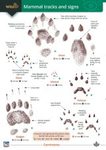![Morphology, Adaptations and Relationships of Plesiorycteropus and a Diagnosis of a New Order of Eutherian Mammals Morphology, Adaptations and Relationships of Plesiorycteropus and a Diagnosis of a New Order of Eutherian Mammals]()
Click to have a closer look
About this book
Related titles
About this book
Plesiorycteropus, an extinct mammal known only from the Quaternary of Madagascar, is conventionally regarded as a tubulidentate and therefore as closely related to extant Orycteropus. However, the shared derived traits that might support such an association have never been adequately identified or critically evaluated. The character analyses presented in this paper reveal that many of the identifiably derived traits of the skeleton of Plesiorycteropus are related to adaptations for digging. Aardvarks possess many of the same adaptations, but so do fossorial members of a broad diversity of other eutherian groups, including Dasypodidae, Manidae, Myrmecophagidae, Lipotyphla, and many others. Identifiably derived traits of Plesiorycteropus that have no obvious connection with digging are few, but the ones that can be adequately documented are by no means unique to aardvarks. Indeed, several of the apparently derived cranial and postcranial traits of Plesiorycteropus specifically echo conditions encountered in primitive ungulates, including various members of the paraphyletic assemblage Condylarthra.
Accordingly, the view that Plesiorycteropus is unambiguously aardvark-like in its morphology and adaptations is not supported in this study. To examine how a parsimony analysis of a stated character set might specify a placement for Plesiorycteropus, a 30-character, 16-taxon data matrix was formatted for the program Phylogenetic Analysis Using Parsimony. Two additional characters, based on morphological assessments of key characters made by Bryan Patterson, were also used in some runs. Although the scale of morphological variation in Plesiorycteropus requires the recognition of two species, P. madagascariensis and P. germainepetterae n. sp., for the characters under consideration interspecific polymorphism was usually found to be negligible. Although in most manipulations of the data matrix Plesiorycteropus tended to group with ungulates sensu lato (including Tubulidentata), its placement was unstable, and an exclusive sister-group pairing of Plesiorycteropus + Tubulidentata was rarely encountered. On the other hand, close pairings with xenarthrans, manids, and lipotyphlans did not occur unless the data matrix was purposely biased in those directions.
As a minimum hypothesis, it may be concluded that Plesiorycteropus is apparently part of the great ungulate 'bush,' but a more exact placement is not convincingly provided by any of the cladistic solutions investigated. One resolution of this problem would be to refer Plesiorycteropus to superorder Ungulata as incertae sedis, but this would make it the only Recent mammal lacking a recognized ordinal affiliation. An alternative would be to consider Plesiorycteropus to be the sole known member of its own order. This is the resolution preferred here, on the ground that Plesiorycteropus is as morphologically distinctive as any eutherian group currently granted ordinal status. The new order Bibymalagasia is created for its reception.
Customer Reviews


























![How to Find and Identify Mammals [Revised Edition]](http://mediacdn.nhbs.com/jackets/jackets_resizer_medium/21/210208.jpg?height=150&width=106)














